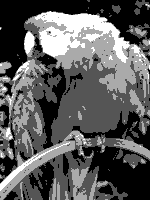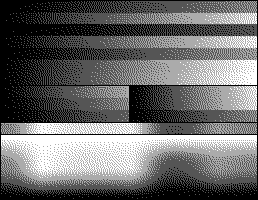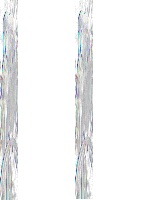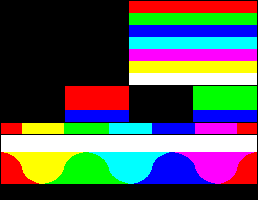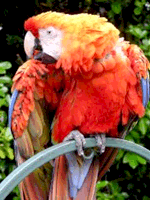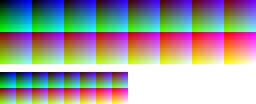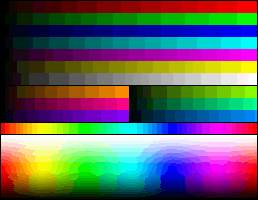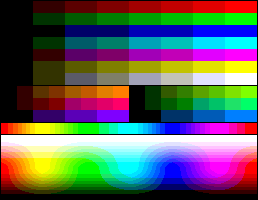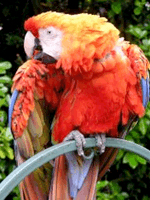List of monochrome and RGB palettes
- For a full listing of computer's color palettes, see List of palettes
This list of monochrome and RGB palettes includes generic repertoires of colors (color palettes) to produce black-and-white and RGB color pictures by a computer's display hardware, not necessarily the total number of such colors that can be simultaneously displayed in a given text or graphic mode of any machine. RGB is the most common method to produce colors for displays; so these complete RGB color repertoires have every possible combination of R-G-B triplets within any given maximum number of levels per component.
For specific hardware and different methods to produce colors other than RGB, see the List of 8-bit computer hardware palettes, the List of 16-bit computer hardware palettes and the List of videogame consoles palettes. For various software arrangements and sorts of colors, including other possible full RGB arrangements within 8-bit color depth displays, see the List of software palettes.
Each palette is represented by a series of color patches. When the number of colors is low, a 1-pixel-size version of the palette appears below it, for easily comparing relative palette sizes. Huge palettes are given directly in one-color-per-pixel color patches.
For each unique palette, an image color test chart and sample image (truecolor original follows) rendered with that palette (without dithering) are given. The test chart shows the full 256 levels of the red, green, and blue (RGB) primary colors and cyan, magenta, and yellow complementary colors, along with a full 256-level grayscale. Gradients of RGB intermediate colors (orange, lime green, sea green, sky blue, violet, and fuchsia), and a full hue spectrum are also present. Color charts are not gamma corrected.
These elements illustrate the color depth and distribution of the colors of any given palette, and the sample image indicates how the color selection of such palettes could represent real-life images. These images are not necessarily representative of how the image would be displayed on the original graphics hardware, as the hardware may have additional limitations regarding the maximum display resolution, pixel aspect ratio and color placement. For simulated sample images for notable computers, see the List of 8-bit computer hardware palettes and List of 16-bit computer hardware palettes articles.
Monochrome palettes
These palettes only have some shades of gray, from black to white, both considered the most possible darker and lighter "grays", respectively. The general rule is that those palettes have 2n different shades of gray, where n is the number of bits needed to represent a single pixel.
Monochrome (1-bit)
Monochrome graphics displays typically have a black background with a white or light gray image, though green and amber monochrome monitors were also common. Such a palette requires only one bit per pixel.
Where photo-realism was desired, these early computer systems had a heavy reliance on dithering to make up for the limits of the technology.
In some systems, as Hercules and CGA graphic cards for the IBM PC, a bit value of 1 represents white pixels (light on) and a value of 0 the black ones (light off); others, like the Atari ST and Apple Macintosh with monochrome monitors, a bit value of 0 means a white pixel (no ink) and a value of 1 means a black pixel (dot of ink), which it approximates to the printing logic.
2-bit Grayscale
In a 2-bit color palette each pixel's value is represented by 2 bits resulting in a 4-value palette (22 = 4).
2-bit dithering:
It has black, white and two intermediate levels of gray as follows:
A monochrome 2-bit palette is used on:
- NeXT Computer, NeXTcube and NeXTstation monochrome graphic displays.
- Original Game Boy system portable videogame console.
- Macintosh PowerBook 150 monochrome LC displays.
- Commodore Amiga with A2024 monochrome monitor in high-resolution mode.[1]
- The original Amazon Kindle
- The original Wonderswan
4-bit Grayscale
In a 4-bit color palette each pixel's value is represented by 4 bits resulting in a 16-value palette (24 = 16):
4-bit grayscale dithering does a fairly good job of reducing visible banding of the level changes:
A monochrome 4-bit palette is used on:
- MOS Technology VDC (on the Commodore 128 with monochrome monitor)
- Amstrad CPC series with a GT64/GT65 Green Monitor (16 unique green shades)
- Amstrad CPC Plus series with the MM12 Monochrome monitor (16 shades of grey)
- Some Apple PowerBooks equipped with monochrome displays like the PowerBook 5300
8-bit Grayscale
In an 8-bit color palette each pixel's value is represented by 8 bits resulting in a 256-value palette (28 = 256). This is usually the maximum number of grays in ordinary monochrome systems; each image pixel occupies a single memory byte.
Most scanners can capture images in 8-bit grayscale, and image file formats like TIFF and JPEG natively support this monochrome palette size.
Alpha channels employed for video overlay also use (conceptually) this palette. The gray level indicates the opacity of the blended image pixel over the background image pixel.
Regular RGB palettes
Here are grouped those full RGB hardware palettes that have the same number of binary levels (i.e., the same number of bits) for every red, green and blue components using the full RGB color model. Thus, the total number of colors are always the number of possible levels by component, n, raised to a power of 3: n×n×n = n3.
3-bit RGB
3-bit RGB dithering:
Systems with a 3-bit RGB palette use 1 bit for each of the red, green and blue color components. That is, each component is either "on" or "off" with no intermediate states. This results in an 8-color palette ((21)3 = 23 = 8) that have black, white, the three RGB primary colors red, blue and green and their correspondent complementary colors cyan, magenta and yellow as follows:
The color indices vary between implementations; therefore, index numbers are not given.
The 3-bit RGB palette is used by:
- The ECMA-48 standard for text terminals (sometimes known as the "ANSI standard", although ANSI X3.64 does not define colors)
- Teletext Level 1/1.5 Teletext.
- Videotex
- TRS-80 Color Computer (in graphics mode, only 4 colors can be displayed simultaneously from fixed 4-colors palettes)
- Oric
- BBC Micro
- The original NEC PC8801 up to the MkII
- The original NEC PC9801 with original 8086 CPU before the VM/VX models
- All Sharp X1 models before the X1 Turbo Z
- The Sharp MZ 700
- Fujitsu FM-7, FM New 7, FM 77 before the FM77AV
- Sinclair QL
- The Macintosh SE with a color printer or external monitor
- The SECAM version of the Atari 2600
6-bit RGB
Systems with a 6-bit RGB palette use 2 bits for each of the red, green, and blue color components. This results in a (22)3 = 43 = 64-color palette as follows:
6-bit RGB systems include the following:
- Enhanced Graphics Adapter (EGA) for IBM PC/AT (only 16 colors can be displayed simultaneously)
- Sega Master System videogame console
- GIME for TRS-80 Color Computer 3 (only 16 colors can be displayed simultaneously)
- Pebble Time smartwatch which has a 6-bit (64 color) e-paper display
9-bit RGB
Systems with a 9-bit RGB palette use 3 bits for each of the red, green, and blue color components. This results in a (23)3 = 83 = 512-color palette as follows:
9-bit RGB systems include the following:
- Atari ST (Normally 4 to 16 at once without tricks)
- MSX2 computers (up to 256 at once)
- Sega Genesis videogame console (64 at once)
- Sega Nomad
- TurboGrafx-16 (NEC PC-Engine)
- The NEC PC8801 Mk II SR and later models (8 of them at once)
- The Mindset computer
12-bit RGB
Systems with a 12-bit RGB palette use 4 bits for each of the red, green, and blue color components. This results in a (24)3 = 163 = 4096-color palette as follows:
12-bit RGB systems include the following:
- Amiga OCS/ECS (32, 64, or 4,096 colors)
- Apple IIgs Video Graphics Chip (3,200 colors)
- Atari STe (16 colors)
- Acorn Archimedes
- Sega Game Gear (32 colors)
- Hi-Text Level 2.5+ Teletext
- Neo Geo Pocket Color (147 colors)
- Atari Lynx (16 colors)
- NEC PC-9801 VM/VX models typically equipped with a NEC V30 or better, but before the PC9821 Series.
- The Sharp X1 Turbo Z Series
- Fujitsu FM-77AV
- The Amstrad CPC 664Plus, 6128Plus and GX4000 (32 colors)
- NeXTstation Color and NeXTstation Turbo Color
- WonderSwan Color
15-bit RGB
Systems with a 15-bit RGB palette use 5 bits for each of the red, green, and blue color components. This results in a (25)3 = 323 = 32,768-color palette (commonly known as Highcolor) as follows:
15-bit systems include:
- Super Nintendo Entertainment System (256 colors)
- Truevision TARGA and AT-Vista graphic cards for IBM PC-AT and compatibles, and NU-Vista for Apple Macintosh
- Later models of Super VGA (SVGA) IBM PC compatible graphic cards
- Nintendo Game Boy Color/Advance/SP/Micro pocket videoconsoles
- Nintendo DS (2D output)
- Neo Geo AES/Neo Geo CD videogame consoles (4096 colors)
- The Sega 32X Addon for the Mega Drive/Genesis
18-bit RGB
Systems with an 18-bit RGB palette use 6 bits for each of the red, green, and blue color components. This results in a (26)3 = 643 = 262,144-color palette as follows:
18-bit RGB systems include the following:
- Video Graphics Array (VGA) for IBM PS/2 and IBM PC compatibles (256 simultaneous colors from a palette of 262,144)
- Atari Falcon (256 colors)
- Nintendo DS (3D output and 2D blended output)
- Used internally by many LCD monitors
24-bit RGB
Often known as truecolor and millions of colors, 24-bit color is the highest color depth normally used, and is available on most modern display systems and software. Its color palette contains (28)3 = 2563 = 16,777,216 colors. This is approximately the number of individual colors the human eye can distinguish within the limited gamut of a typical display.
The complete palette needs a squared image of 4,096 pixels wide (50MB in memory), and there is not enough room in this page to show it at full. An image of the full palette can be found here.
This can be imagined as 256 stacked squares like the following, every one of them having the same given value for the red component, from 0 to 255.
The color transitions in these patches must be seen as continuous. If you see color stepping (banding) inside, then probably your display is using a Highcolor (15- or 16- bits RGB, 32,768 or 65,536 colors) mode or lesser.

Red = 0
Red = 85 (1/3 of 255)
Red = 170 (2/3 of 255)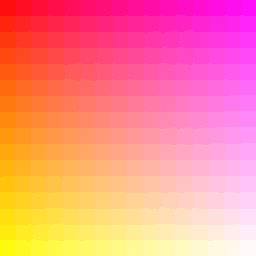
Red = 255
This is also the number of colors used in true color image files, like Truevision TGA, TIFF, JPEG (the last internally encoded as YCbCr) and Windows Bitmap, captured with scanners and digital cameras, as well as those created with 3D computer graphics software.
24-bit RGB systems include:
- Amiga Advanced Graphics Architecture (256 or 262144 colors)
- Nintendo 3DS
- PlayStation Vita
- Later models of Super VGA (SVGA) IBM PC compatible graphic cards
- Truevision AT-Vista graphic cards for IBM PC-AT and compatibles, and NU-Vista for Apple Macintosh.
- The Philips CD-i
30-bit RGB
| (No simulation available) |
Some newer graphics cards support 30-bit RGB and higher. Its color palette contains (210)3 = 10243 = 1,073,741,824 colors. However, there are few operating systems or applications that support this mode yet. For some people, it may be hard to distinguish between higher color palettes than 24-bit color offers. However, the range of luminance, or gray scale, offered in a 30-bit color system would have 1,024 levels of luminance rather than the 256 of the common standard 24-bit, to which the human eye is more sensitive than to hue.
Non-regular RGB palettes
These also are full RGB palette repertories, but either they do not have the same number of levels for every red, green and blue components, or they are bit levels based. Nevertheless, all of them are used in very popular personal computers.
For further details on color palettes for these systems, see the article List of 8-bit computer hardware palettes.
4-bit RGBI
The 4-bit RGBI palette is similar to the 3-bit RGB palette but adds one bit for intensity. This results in each of the colors of the 3-bit palette to have a dark and bright variant giving a total of 23×2 = 16 colors.
This 4-bits RGBI schema is used in several platforms with variations, so the table given below is a simple reference for the palette richness, and not an actual implemented palette. For this reason, no numbers are assigned to each color, and color order is arbitrary.
Note that "dark white" is a lighter gray than "bright black".
The 4-bits RGBI palettes are used by:
- Color Graphics Adapter, with brown instead of dark yellow). On CGA, setting a color "bright" added ⅓ of the maximum to all three channels' brightness, so the "bright" colors were whiter shades of their 3-bit counterparts. Each of the other bits increased a channel by ⅔, except that dark yellow had only ⅓ green and was therefore brown instead of ochre.
- The CGA palette was the default for EGA, VGA and Microsoft Windows 3.x (on the IBM PC and compatibles), although other palettes were available.
- MOS Technology VDC (on the Commodore 128)
- ZX Spectrum (with two black, black with bright is the same as black without bright)
- TI 99/4A / MSX (These use the TMS9918 video chip. The colors do not conform to the image above, but has instead: transparency, black, medium green, light green, dark blue, dark purple, brown, cyan, dark red, orange, dark yellow, light yellow, dark green, medium purple, gray, and white.)
- Sharp MZ 800
3-level RGB
The 3-level ('not' bits) RGB uses three level for every red, green and blue color components, resulting in a 33 = 27 colors palette as follows:
This palette is used by:
- The Amstrad CPC 464 series of personal computers excluding the Plus models
- The Toshiba Pasopia 7
3-3-2 bit RGB
The 3-3-2 bit RGB use 3 bits for each of the red and green color components, and 2 bits for the blue component, due to the lesser sensitivity of the common human eye to this primary color. This results in an 8×8×4 = 256-color palette as follows:
This palette is used by
- The MSX2 series of personal computers.
- Palette 4 of the IBM PGC (palette 2 gives 2-3-3 bit RGB and palette 3 gives 3-2-3 bit RGB).
- VGA built-in output of the Digilent Inc. NEXYS 2, NEXYS 3 and BASYS2 FPGA boards.
- The Uzebox gaming console
- SGI Indy 8-bit XL graphics
- The Tiki 100 personal computer (only 16 colors can be displayed simultaneously)
16-bit RGB
Most modern systems support 16-bit color. It is sometimes referred to as Highcolor (along with the 15-bit RGB), medium color or thousands of colors. It utilizes a color palette of 32×64×32 = 65,536 colors. Usually, there are 5 bits allocated for the red and blue color components (32 levels each) and 6 bits for the green component (64 levels), due to the greater sensitivity of the common human eye to this color. This doubles the 15-bit RGB palette.
The 16-bit RGB palette using 6 bits for the green component:
The Atari Falcon and the Extended Graphics Array (XGA) for IBM PS/2 use the 16-bit RGB palette.
It must be noticed that not all systems using 16-bit color depth employ the 16-bit, 32-64-32 level RGB palette. Platforms like Sharp X68000 or the Neo Geo videogame console employs the 15-bit RGB palette (5 bits are used for red, green, and blue), but the last bit specifies a less significant intensity or luminance. The 16-bit mode of the Truevision TARGA/AT-Vista/NU-Vista graphic cards and its associated TGA file format also uses 15-bit RGB, but it devotes its remaining bit as a simple alpha channel for video overlay. The Atari Falcon can also be switched into a matching mode by setting of an "overlay" bit in the graphics processor mode register when in 16-bit mode, meaning it can actually display in either 15- or 16-bit color depth depending on application.
See also
- Palette (computing)
- Indexed color
- Color Lookup Table
- Computer display
- List of home computers by video hardware
- Bitmap
- Grayscale
Notes
External links and sources
- HTML Color Codes Dynamic color palette with HTML color codes information






